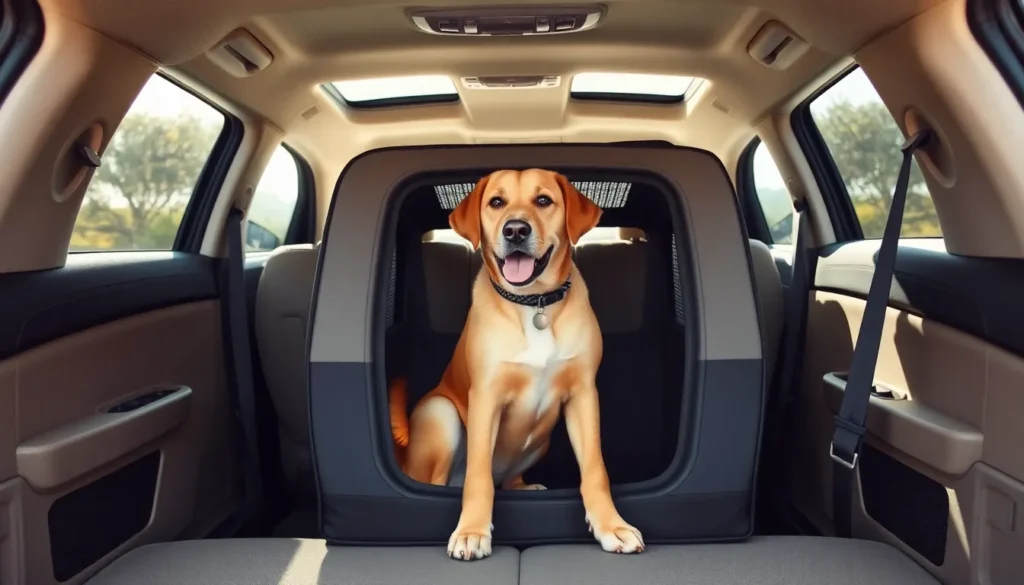Table of Contents
ToggleImagine gearing up for a road trip, the windows rolled down, the wind whipping through your hair, and your furry friend seated comfortably in the back. Sounds dreamy, right? But wait. Before you hit the open road, there’s one essential item you can’t overlook, a large dog travel crate. Not only does it keep your pooch safe during the journey, but it also ensures that your car remains fur-free and scratch-free. Whether it’s a quick trip to the vet or a cross-country adventure, understanding the ins and outs of large dog travel crates can make all the difference. Let’s immerse and explore everything you need to know about this must-have travel gear.
Understanding the Importance of Travel Crates for Large Dogs

Traveling with a large dog can feel like a challenge, but it doesn’t have to be. A travel crate serves as a secure haven for your canine companion, providing a sense of familiarity and safety in an unfamiliar environment. These crates offer a designated space for them to relax and stick to their routines, which is crucial when introducing them to new sights, sounds, and smells.
Also, many travel crates come equipped with features that can enhance your dog’s comfort. Think of a travel crate as a sturdy yet cozy shell that protects your pet from the chaos of travel. If your dog experiences anxiety during car rides, a well-ventilated, spacious crate can act as a calming retreat.
Importantly, safety is paramount while traveling. A crate confines your dog in the vehicle, preventing potential distractions for the driver. And should the unexpected occur, like sudden braking or an accident, the crate can help minimize injury to your dog. It’s about providing peace of mind for both you and your furry buddy.
Choosing the Right Size Crate for Your Large Dog
Finding the perfect size crate is not just about dimensions: it’s about ensuring your dog has enough space to sit, stand, turn around, and lie down comfortably. A good rule of thumb? Measure your dog’s height and length while they’re standing. When selecting a crate, you generally want one that’s about 2-4 inches longer and taller than your dog’s measurements. This provides enough wiggle room without feeling too spacious, which could lead to your dog moving around too much while in transit.
Most large dog travel crates don’t come in a one-size-fits-all approach. Instead, they often cater to specific breeds and their respective sizes. Brands usually offer size charts to help narrow down the best fit for your pup. For instance, a Great Dane will have different crate size requirements than a Boxer, even if both fall into the “large dog” category. Understanding your dog’s specific needs will ensure they remain comfortable and secure during travels.
Types of Large Dog Travel Crates
When it comes to large dog travel crates, variety is the spice of life, or in this case, the key to finding the right match for your furry friend. Broadly speaking, there are two main types of crates: soft-sided and hard-sided.
Soft-Sided Crates:
These are typically lightweight and portable, making them ideal for travel by air or road. They often feature mesh panels for ventilation and visibility, which many dogs find comforting. But, they’re best suited for calm dogs who won’t chew through their surroundings.
Hard-Sided Crates:
These are heavier and offer more protection, making them an excellent choice for larger and more energetic dogs. Constructed from durable materials like plastic or metal, these crates are usually recommended for air travel based on airline regulations. But, they can be less portable than their soft counterparts.
Both styles have their advantages, and your choice will often depend on your dog’s behavior and your travel plans.
Key Features to Look for in a Large Dog Travel Crate
Not all crates are created equal. When shopping for a large dog travel crate, certain features can make your purchase worthwhile.
Ventilation: Ensure there’s adequate airflow. Many models include multiple vents or mesh panels to keep your pup comfortable and cool during travels.
Safety Locks: A secure lock can give you peace of mind. Look for crates that include heavy-duty mechanisms to prevent your dog from accidentally escaping.
Durability: Choose materials that can withstand wear and tear. Opt for crates made from heavy-duty plastic or sturdy metal to ensure longevity.
Portability: If you travel frequently, consider how easy it is to transport the crate. Look for foldable models or ones with built-in handles for added convenience.
By focusing on these key features, you can set your dog up for a comfortable and secure travel experience.
Traveling with Your Large Dog: Tips for a Smooth Journey
With all the preparations in place, it’s time to hit the road. To enhance the travel experience for both you and your dog, here are some helpful tips:
- Pre-Travel Adjustments: Before embarking on your journey, let your dog acclimate to their crate. Spend time with them inside the crate, offering treats and toys to create positive associations.
- Regular Breaks: Schedule stops during long drives. Allow your dog time to stretch, relieve itself, and enjoy some fresh air. This can significantly mitigate any travel stress.
- Hydration: Don’t forget to bring water. Keeping your dog hydrated is crucial, particularly if you’re traveling in warmer climates. A spill-proof water bowl can be a game-changer.
- Comfort Items: Bring along some of your dog’s favorite toys or a blanket. Familiar scents can provide comfort and ease any anxiety they might feel during the trip.
Implementing these simple strategies can lead to smoother travels with your large dog.
Proper Crate Training for Large Dogs
Like most things, crate training takes a bit of patience but is well worth the effort in the end. Start by introducing the crate as a welcoming space.
- Make it Inviting: Place blankets and toys inside the crate. Create a cozy environment your dog wants to explore.
- Short Sessions: Begin with short intervals. Close the door for just a few minutes while you’re nearby. Gradually increase the time they spend inside the crate.
- Positive Reinforcement: Reward your dog for entering the crate willingly. Whether it’s treats, praise, or playtime, positive reinforcement strengthens their association with the crate.
- Consistency is Key: Establish a routine where your dog associates the crate with relaxation and safety, as a consistent approach leads to desirable crate behavior.







